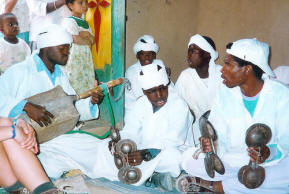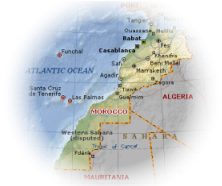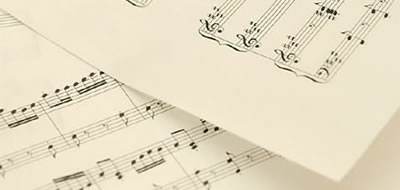Morocco is inhabited mostly by Arabs along with Berbers and other minorities. Its music is predominantly Arab, but Andalusian and other imported influences have had a major effect on the country's musical character. Rock-influenced shaabi bands are widespread, as is trance music with historical origins in Muslim music.
Andalusian classical music
1. Morocco is home to Andalusian classical music that is found throughout North Africa. It probably evolved under the Moors in Cordoba, and the Persian-born musician Ziryab is usually credited with its invention. Ziryab invented the Nawbah, a suite which forms the basis of al-âla, the primary form of Andalusian classical music today, along with Gharnati and Malhoun.
There used to be twenty-four Nawbah linked to each hour of the day, but only four Nawbah have survived in their entirety, and seven in fragmentary form. An entire Nawbah can last six or seven hours and are divided into five parts called mizan, each with a corresponding rhythm. The rhythms occur in the following order in a complete Nawbah:
- basît (6/4)
- qaum wa nusf (8/4)
- darj (4/4)
- btâyhi (8/4)
- quddâm (3/4 or 6/8)
Each mizan begins with instrumental preludes called either tuashia, m'shaliya or bughya, followed by as many as twenty songs (sana'a) in the entire mizan.
Andalusian classical schools are spread across Morocco, having left Spain when the Moors and Jews were driven out of the country. Valencia's school is now in Fez, while Granada's is located in Tetouan and Chefchaouen. Cities like Tangier and Meknes have their own orchestras as well.
Jews in Morocco played an important role in the perpetuation of this oral tradition. In fact, the late Rabbi David Bouzaglo was known to have a conservatory of sorts in Casablanca where a number of Arab and Jewish musicians trained in al-Ala.
Andalusian classical music uses instruments including Oud (lute), Rabab (fiddle), Darbouka (goblet drums), taarija (tambourine), Qanoon (zither) and kamenjah (violin). Other instruments have included pianos, banjos and clarinets, though none of these instruments lasted for long.
Andalusian classical music orchestras are spread across the country, including the cities of Fez, Tetouan, Chaouen, Tangier, Meknes, Rabat and Casablanca.
Andalusian Nawbah
Andalusi nubah (أندلسي نوبة) is a genre found in the North African Maghrib states of Morocco, Algeria, Tunisia, and Libya but, as the name indicates, of Spanish origin. The name replaced the older use of sawt and originates from the musician waiting behind a curtain to be told it was his turn or nawbah by the sattar or curtain man (Touma 1996, p. 68).
Lyrics are sung by the soloist or in unison by the chorus are chosen from the muwashshah or zajal poetic forms, being in classical and colloquial Arabic, respectively. (ibid, pp. 70-71).
Andalusi nubah uses one tab' (similar to maqam) per performance, and includes several instrumental pieces and predominantly vocal pieces accompanied by instrumentation. These differ as to mizan or rhythmic pattern (wazn) (ibid, p. 68).
Formally the tempo increases while the awzan simply within each of five sections, called mizan. The sections are introduced by short instrumental pieces and vary according to region, the name indicating the awzan used:
• in Algeria: msaddar, btayhi, darj, insiraf, khlas
• in Tunisia: btaybhi, barwal, darj, khafif, khatm
• in Morocco: basit, qayim wa-nisf, btayhi, darj, quddam
The ensemble used includes the ud, rabab or rebec, nay, box zither, tambourine, and goblet drum, the players of which also serve as chorus (ibid, p. 70).
Gharnati
Gharnati is found in both Morocco and Algeria, primarily popular in Rabat and Oujda in Morocco. It is arranged in nuba like al-âla; there are four unfinished nuba and twelve complete ones. Orchestras consist of kvîtra, mandolin, banjo, oud and kamenjah. The word "Gharnati" comes from the Andalusian city of Granada.
Gharnati
refers to a variety of Moroccan music
originating in Andalusia. Its name is related,
being derived from the Arabic name of the
Spanish city of Granada.
Gharnati
constitutes the musical mode most used in the
Moroccan city of Oujda, where besides this
musical kind is omnipresent and where one
organizes each year in June the International
Festival of the Gharnati
music. This musical art was preserved mainly at
Tlemcen in Algeria
and Oujda, near the Algerian border.
Famous
musicians of Gharnati
•
Hassan El Hayek
•
Sheik Salah
Chaabane,
•
Bouchnak
Benyounes says
Afendi
• Kerzazi Sheik Brahim.
Berber music
There are three varieties of Berber folk music: village and ritual music, and the music performed by professional musicians.
Village music is performed collectively for dancing, including ahidus and ahouach dances. Instruments include flutes and drums. These dances begin with a chanted prayer. Ritual music is performed at regular ceremonies to celebrate marriages and other important life events. Ritual music is also used as protection against evil spirits. Professional musicians (imdyazn) travel in groups of four, led by a poet (amydaz). The amydaz performs improvised poems, often accompanied by drums and Rabab (a one-stringed fiddle), along with a bou oughanim who plays a double clarinet and acts as a clown for the group.
The Chleuh Berbers have professional musicians called rwais who play in ensembles consisting of lutes, rababs and cymbals, with any number of vocalist. The leader, or rayes, leads the choreography and music of the group. These performances begin with an instrumental astara on rabab, which also gives the notes of the melody which follows. The next phase is the amarg, or sung poetry, and then ammussu, a danced overture, tammust, an energetic song, aberdag, a dance, and finally the rhythmically swift tabbayt. There is some variation in the presentation of the order, but the astara always begins, and the tabbayt always ends.
Berber music
The Berbers are an ethnic group in North and West Africa. Their music is widely varying across the area they inhabit, but is best known for its place in Moroccan music, the popular Kabylian and chawi music of Algeria and the widespread Tuareg music of Burkina Faso, Niger and Mali.
Algeria
The region of Kabylia in Algeria has a very large Berber population. Traditional Kabylian music consists of vocalists accompanied by a rhythm section, consisting of t'bel (tambourine) and bendir (frame drum), and a melody section, consisting of a ghaita (bagpipe) and ajouag (flute).
Kabylian music has been famous in France since the 1930s, when it was played at cafés. As it evolved, Western string instruments and Arab musical conventions, like large backing orchestras, were added. After the independence of Algeria and Kabylian culture was oppressed, many musicians began to adopt politicized lyrics. The three most popular musicians of this era were Ferhat Mehenni, Lounis Ait Menguellet and Idir, whose "A Vava Inouva" (1973) brought international attention for Kabylian music and laid the groundwork for the breakthrough of raï.
By the time raï, a style of Algerian popular music, became popular in France and elsewhere in Europe, Kabylian artists were also moving towards popular music conventions. Hassen Zermani's all-electric Takfarinas and Abdelli's work with Peter Gabriel's Real World helped bring Kabylian music to new audiences, while the murder of Matoub Lounes inspired many Kabylians to rally around their popular musicians.
Modern singers include Djur Djura and many chawi singers and groups as: Houria Aichi, Les Berberes, Ithran, Amirouch, Massinissa, Amadiaz, Numidas, Mihoub, Massilia, Merkunda, Thiguyer, Salim Souhali (Thaziri), Dihya, Messaoud Nedjahi and others.
Morocco

Berber musicians from the Ourika valley
Berbers are a solid majority of Morocco's population, but are nevertheless politically marginalized. Their most famous musical output is likely Najat Aatabou, a singer whose debut cassette, "J'en ai Marre", sold an unprecedented half a million copies in Morocco. Internationally, the Master Musicians of Jajouka are also well known, as a result of their collaboration with Brian Jones of the Rolling Stones and poet William Burroughs. Another recording group from Jajouka is Master Musicians of Joujouka, formerly managed by the late painter Mohamed Hamri.
Chaabi
Chaabi (popular) is a music consisting of numerous varieties which are descended from the multifarious forms of Moroccan folk music. Chaabi was originally performed in markets, but is now found at any celebration or meeting.
Chaabi songs typically end with a leseb, or swift rhythmic section accompanied by syncopated clapping.
A sophisticated form of chaabi evolved in the 1970s competing with popular Egyptian and Lebanese music. These chaabi groups consisted of a lute and a hadjuj, with some form of drum. Eventually, new instruments like buzuks and electric guitars were added. The three most important early groups were Lemchaheb, Nass El Ghiwane and Jil Jilala. All three bands featured politicized lyrics that got the songwriters in trouble with the government.
The 1980s saw a new wave of modernizing bands like Muluk El Hwa and Nass El Hal.
Gnawa

Gnawa musicians in Morocco
Gnawa music is considered a mystical music. It was gradually brought to Morocco by Sub-Saharan Africans and later became part of the Moroccan tradition. The ritual of the gnawa (or gnaoua) follow rules, that are part from the muslim sufi tradition and partly of African animistic origin similar to the traditions that are found in the african diaspora, Brazil, Cuba, Haiti and so forth. The centre of the ritual is the so-called "leelah" (the night), also called "derdeba", the night of trance. Here the seven spirits are evoked through around 100 chants. Especially in the Muslim month of Sha'aban, which is just before Ramadan, there are "leelahs" held in the gnawa community.
Malhoun
Milhûn is a form of sung poetry which uses many of the same modes and instruments as al-âla. A milhûn suite comprises two parts, the taqsim overture played on an oud or violin in a free rhythm to introduce the mode for the rest of the piece, followed by the qassida, or sung poem which is itself divided into three parts. These are the solo verses (al-aqsâm), choral refrain (al-harba) and crescendoing chorus that completes the suite (al-dîdka).
Thami Lamdaghri is perhaps the best-known milhûn composer, known for songs like "Al-Gnawi" and "Aliq Al-Masrûh".
Milhûn orchestras include oud, kamenjah, darbuka, handqa (small cymbals), hadjouj (a bass lute) and swisen (a high-pitched lute).
Malhun (or Milhûn, in Arabic الملحون) meaning the melodic poem is a Moroccan music that borrows its modes from the Andalusian music. It is a kind of urban, sung poetry that comes from the exclusively masculine working-class milieu of craftsmen's guilds.
Origins
The melhun, originally a pure literary creation, emerged as a poetic art today known in Morocco under the name of Qasida (meaning poem) (in Arabic القصيدة) or zajal (in Arabic الزجل). Combined with music, it quickly spread across the country where it acquired fame particularly among artisans.
Music
The qassida (laqsida in Moroccan arabic) of the malhun is based on two essential elements: the overtures preceding it and the parts of which it is composed. aqsâm (in Arabic الاقسام) verses sung solo interrupted by the harba refrain (meaning launch) (in Arabic الحربة). Harba, the origin of which goes back to the 16th century, is a refrain taken up between the verses by the sheddâda (group of singers and instrumentalist-singers)(in Arabic الشداشة). Another refrain called dridka in Arabic الدريدكة) is a simplified form of the harba, taking off from an accelerated rhythm to announce the end of a qassida.
The qassida however preserved the division of the text in stanzas as in the Andalusian song: the verse (ghson meaning branch) can include from eight to sixteen verses, a short refrain or harba offers an alternation which makes it possible to break the monotony of the musical discourse of the Malhoun song. This gave rise to the sûruf, subsidiary procedures employed by singers to produce an even greater effect on the audience and above all to correct the rhythm. Abdelaziz al-Maghrawi (16th 17th centuries) created from dân, a word that has no meaning, verses which were used as the basis for versewriting by Moroccan folk poets. (e.g. Dân dâni yâ dâni dân dân yâ dân).
Famous figures
Among the former authors of melhoun, there is Abdelaziz al-Maghrawi and Abderrahman El Majdoub (died 1568) who was famous for his mystical quatrains. In 18th and 19th centuries, Morocco knew a great number of poets who, from Fez, Meknes or Marrakech spread popular poetry who adopted the melhoun. In modern days, Haj Houcine Toulali (1924-1998) was the most prominent figure in the malhun music.
Rai
Rai is more closely associated with Algeria in the international music scene, but Morocco has produced its own stars like Cheb Mimoun and Hanino. Especially in the eastern regions of Morocco Oujda and Berkane the Rai-style has gained a lot of popularity in the beginning of the early 90s. The two major cities in the east of Morocco, Berkane and Oujda have become centres of the new revived Rai-style in Morocco. The huge presence of Algerian-born people in the East is the major factor of popularity.
Alternative Rock
Sourced from Reading UK, the edge sound of 3 piece band Lazywall grooves into the riff of a new breed that’s tuned into the alternative rock scene. Formed in 2003, the band’s three members include, Monz(drums) and front man Nao(bass), combine their influences from bands like Audioslave, Pearl Jam, Red Hot Chilli Peppers and Staind into a sound that’s familiar, addictive and drawn from influence, while remaining distinctly Lazywall http://www.lazywall.com/
Sufi music
Sufi brotherhoods (tarikas) are common in Morocco, and music is an integral part of their spiritual tradition, in contrast to most other forms of Islam, which do not use music. This music is an attempt at reaching a trance state which inspires mystical ecstasy. The brothers hold hands in a circle and chant or dance. Sufi music is usually without rhythm.
Marrakech and other regions in southern Morocco are home to the Gnawa Brotherhood, which claims descent from the Ethiopian muezzin Sidi Bilal. Gnaoua ceremonies (deiceba) are used to protect against mental illness, scorpion stings and malicious spirits. Deiceba may be related to Sub-Saharan African ceremonies and use a long-necked lute of African origin called the guembri, as well as castanets called garagab.
The Jilala are another brotherhood, known for their hypnotic and otherworldly music. They are devotees of Moulay Abdelkader Jilali. Instruments include the bendir (frame drum) and qsbah (flute).
Other brotherhoods include Hamadcha (founded by Sidi Ali ben Hamdouch), Aissaoua (founded by Sidi Mohamed ben Aissa, Derkaoua, Haddaoua, Cherkaoua, Dar Damana (the Sufi saints of Ouezzane). A well-known local cult is in village of Jajouka in the Ahl Srif Mountains, home of music group, Master Musicians of Jajouka. This cult commonly flourished near the sanctuary of a local saint. Jajouka musicians play healing music said to be written by their ninth century patron saint Sidi Achmed Schiech. They also perform a ritual called Boujeloud which is likened to the worship of the God Pan.


